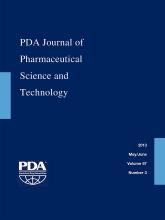Abstract
Objective: To evaluate the relationship between changes in emulsion globule size distributions and container uptake of lipid emulsions in total nutrient admixtures.
Methods: A total nutrient admixture was prepared from a commercial lipid emulsion, 20% ClinOleic®, separated into glass (borosilicate) and ethylene vinyl acetate (EVA) plastic containers, and then stored at ambient conditions for approximately 24 h. The large globule size distribution was monitored continuously for both containers, and the quantity of triglycerides associated with both containers was measured by liquid chromatography. The changes in mass of the EVA containers were also measured gravimetrically.
Results: The volume percent of globules greater than 5 microns in diameter (PFAT5) levels for an emulsion admixture in EVA containers showed a 75% reduction compared to a marginal decrease of PFAT5 when in the glass container. Extraction of the containers showed that the quantity of triglycerides associated with the EVA surfaces steadily increased with emulsion exposure time, while the glass showed a significantly lower triglyceride content compared to the EVA. Gravimetric measurements confirmed that the EVA containers gained significant mass during exposure to the emulsion admixture.
Conclusion: A time-dependent decrease in PFAT5 values for an emulsion admixture was associated with container triglyceride absorption where EVA containers had a greater uptake than glass containers. The larger globules appear to absorb preferentially, and the admixture globule size distribution fraction represented by PFAT5 accounts for 15–20% of the total triglyceride adsorption to the container.
LAY ABSTRACT: The goal of this work is to evaluate how emulsions in total nutrition admixtures are affected by the containers within which they are stored. Specifically, the study examines how the emulsion globule size distribution in different containers is related to adsorption or absorption of the lipids onto or into the container. The admixtures were prepared from a commercial lipid emulsion, 20% ClinOleic®, and the containers were either glass (borosilicate) or plastic (ethylene vinyl acetate, EVA). The large globule size distribution was monitored continuously for both containers over the course of 24 h, and the quantity of triglycerides taken up by both containers was measured by liquid chromatography. The lipid uptake by the EVA containers was also monitored by gravimetric methods. Briefly, the percent of fat globules greater than 5 micrometers (PFAT5) in EVA containers showed a 75% reduction compared to a marginal decrease of PFAT5 when in the glass container. Extraction of the lipids from the containers showed that the quantity of triglycerides associated with the EVA surfaces steadily increased with admixture exposure time, while the glass showed a significantly lower triglyceride content. Gravimetric measurements confirmed that the EVA containers gained measurable mass during exposure to the emulsion admixture.
- © PDA, Inc. 2013
PDA members receive access to all articles published in the current year and previous volume year. Institutional subscribers received access to all content. Log in below to receive access to this article if you are either of these.
If you are neither or you are a PDA member trying to access an article outside of your membership license, then you must purchase access to this article (below). If you do not have a username or password for JPST, you will be required to create an account prior to purchasing.
Full issue PDFs are for PDA members only.
Note to pda.org users
The PDA and PDA bookstore websites (www.pda.org and www.pda.org/bookstore) are separate websites from the PDA JPST website. When you first join PDA, your initial UserID and Password are sent to HighWirePress to create your PDA JPST account. Subsequent UserrID and Password changes required at the PDA websites will not pass on to PDA JPST and vice versa. If you forget your PDA JPST UserID and/or Password, you can request help to retrieve UserID and reset Password below.






